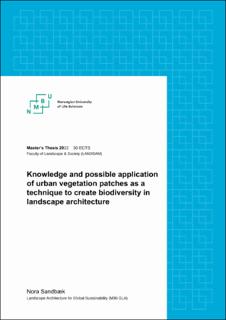| dc.description.abstract | Biodiversity loss is a global issue that is due to land-use changes. A driver behind land use-changes is urbanization. To counter this development, cities create ways to support biodiversity through urban green spaces. Although urban spaces are fragmented, landscape architecture can assist the colonization of species. However, much of urban biodiversity supporting strategies focus on green corridors and connectivity. Even though corridors and patches both have significant positive effects on biodiversity, there is a lack of biodiversity supporting strategies for urban green/vegetation patches. This master thesis addresses the globally applicable factors that has the potential of creating biodiversity in and with urban vegetation patches. The thesis will also include a practical example of how these factors can be applicated in a design. The reason for including a practical example, is because there is lacking a conversion from theory to practise in this field. There can be many interpretations of how to create biodiversity in urban vegetation patches, and practical examples can improve the theoretical information by making it applicable for reality. | |
